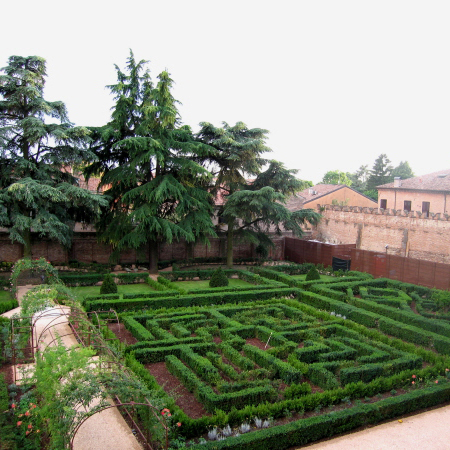
Giardino di Palazzo Costabili
This post is also available in:
 Italiano (Italian)
Italiano (Italian)
Giardino di Palazzo Costabili, also called “palazzo di Ludovico il Moro” since he had it built, is the only complete specimen of formal historic garden of Ferrara. The palace, which is considered one of the masterpieces of the architect Biagio Rossetti, who started building it in 1495, nowadays hosts the national archaeological museum of Ferrara.
Of the original interiors remains not so much; only the “Sala del Tesoro”, located between the honour courtyard and the Italian garden surrounding the building on its Southern and Eastern side.
The southern side of the garden is a reproduction of the original one of the Renaissance, which was realised in the thirties, during the refurbishment works of the building, in an area where the vegetable gardens used to be. After that, many interventions have been made during the fifties, such as the installation of the right shrubs and trees.
The eastern garden, where the gravestones from the Spina necropolis are now shown, presents still a part of the ancient renaissance garden.
A recent and accurate restoration work has been managed by “Direzione Regionale per i Beni Culturali e Paesaggistici dell’Emilia-Romagna” and it has brought the garden to new life, without altering the garden’s importation and geometrical path.
The refurbishment
The recovery project has been commissioned to the architect Maria Luisa Mutschlechner with the collaboration of specialists in many fields and the contribution of “Studio Associato Pangea” of Padova. Among the interventions, there are the one of the box hedges (Buxus sempervirens), of the paths, of the labyrinth and of the roses’ gallery; the rimonda of the cedar trees (Cedrus deodara e Cedrus libani), towards the southern border; the rearrangement of four yews (Taxus baccata); the substitution of thuia and of a magnolia with two pomegranates trees (Punica granatum), which were already present in the garden; the remodelling of the flowerbeds to give them a squared form and put to abode dome herbaceous plants, ground-covers and bulbous plants. Lastly, the boundary wall has been covered with climbing flowers like roses, hortensias and clematis (Clematis armandii).
This post is also available in:
 Italiano (Italian)
Italiano (Italian)
Contatti
C/o Museo Archeologico Nazionale - Via XX Settembre, 122 - Ferrara(FE)
0532 66299
sba-ero.museoarchferrara@beniculturali.it
http://www.archeobologna.beniculturali.it
Altre info
Intero 4,00 euro; ridotto 2,00 euro.
Dal martedì alla domenica
9.00-14.00


